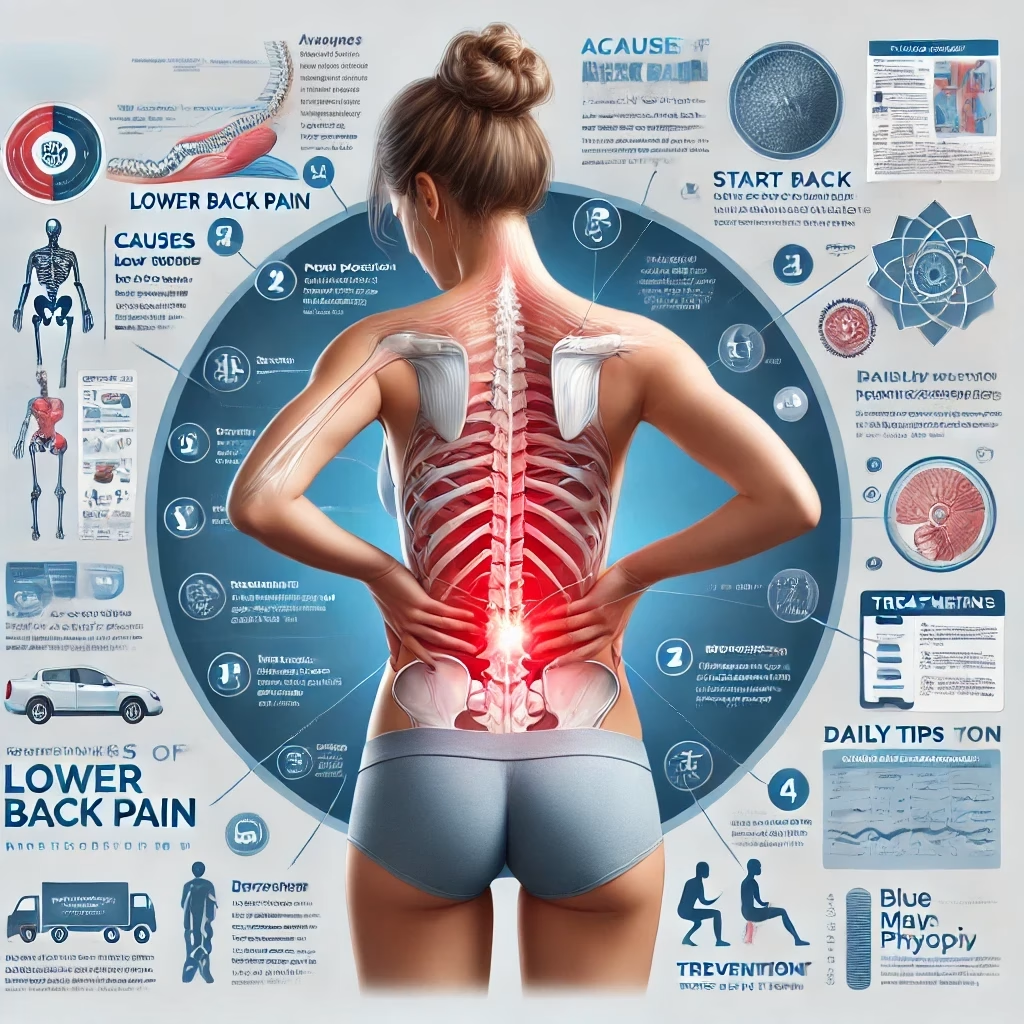Understanding Low back Pain
Understanding and Managing Lower Back Pain
What is Lower Back Pain?
Lower back pain is pain in the area between your lower ribs and buttocks. It can be short-term (acute) or long-term (chronic), and it’s very common, with about one in five UK adults experiencing it at any given time. Most people will have it at some point, and it can affect your daily life, but many recover within a few weeks with proper care.
Lower back pain is pain in the area between your lower ribs and buttocks. It can be short-term (acute) or long-term (chronic), and it’s very common, with about one in five UK adults experiencing it at any given time. Most people will have it at some point, and it can affect your daily life, but many recover within a few weeks with proper care.
Why It Matters
At Blue Maya Physio, we see many patients with lower back pain, and we know how frustrating it can be. Our goal is to help you understand it and manage it effectively, so you can get back to your normal activities. We’re based in Wallington, South London, UK, and we use the latest evidence-based practices, following guidelines from the National Institute for Health and Care Excellence (NICE).
At Blue Maya Physio, we see many patients with lower back pain, and we know how frustrating it can be. Our goal is to help you understand it and manage it effectively, so you can get back to your normal activities. We’re based in Wallington, South London, UK, and we use the latest evidence-based practices, following guidelines from the National Institute for Health and Care Excellence (NICE).
How We Assess It
When you visit us, we’ll assess your pain using tools like the STarT Back risk assessment to see if you’re at risk of long-term issues. This helps us create a plan just for you. Importantly, we usually don’t need X-rays or MRI scans right away, as NICE guidelines suggest imaging is only needed if it will change your treatment, like if you have serious symptoms such as leg weakness or loss of bladder control.
When you visit us, we’ll assess your pain using tools like the STarT Back risk assessment to see if you’re at risk of long-term issues. This helps us create a plan just for you. Importantly, we usually don’t need X-rays or MRI scans right away, as NICE guidelines suggest imaging is only needed if it will change your treatment, like if you have serious symptoms such as leg weakness or loss of bladder control.
How to Manage It
The key is to stay active, not rest too much. Research suggests exercise, like group programs including walking or stretching, can really help. We offer personalized exercise plans and manual therapies, like massage, to reduce pain and improve movement. For some, especially with long-term pain, we might suggest psychological support, like cognitive behavioral therapy (CBT), to help manage any emotional factors.
The key is to stay active, not rest too much. Research suggests exercise, like group programs including walking or stretching, can really help. We offer personalized exercise plans and manual therapies, like massage, to reduce pain and improve movement. For some, especially with long-term pain, we might suggest psychological support, like cognitive behavioral therapy (CBT), to help manage any emotional factors.
If painkillers are needed, NICE recommends considering non-steroidal anti-inflammatory drugs (NSAIDs) like ibuprofen, but with caution due to side effects, and not paracetamol alone. Opioids are generally not advised for chronic pain, so we focus on non-drug treatments first.
Daily Tips to Help
- Sit and stand up straight to maintain good posture.
- Take breaks if you sit for long periods, like at work.
- Lift heavy objects by bending your knees, not your back.
- Keep moving with activities like swimming or walking to keep your back strong.
When to Seek More Help
If your pain doesn’t improve after a few weeks, or if you have severe pain, numbness in your legs, trouble with bladder or bowel control, unexplained weight loss, or fever, please contact us or your doctor. These could be signs of a more serious issue.
If your pain doesn’t improve after a few weeks, or if you have severe pain, numbness in your legs, trouble with bladder or bowel control, unexplained weight loss, or fever, please contact us or your doctor. These could be signs of a more serious issue.
About Blue Maya Physio
We’re a private physiotherapy clinic in Wallington, South London, UK, dedicated to helping you with evidence-based care. If you have questions or need support, reach out to us:
*This post is for information only and isn’t a substitute for medical advice. We’re here to help you live pain-free.
We’re a private physiotherapy clinic in Wallington, South London, UK, dedicated to helping you with evidence-based care. If you have questions or need support, reach out to us:
*This post is for information only and isn’t a substitute for medical advice. We’re here to help you live pain-free.





